In this comprehensive guide, you will learn the essential steps and techniques required to flawlessly paint a tailgate using spray paint. Whether you are a seasoned DIY enthusiast or a beginner looking to enhance the appearance of your vehicle, this article will provide you with a step-by-step process that guarantees professional results. From selecting the right materials and properly preparing the surface to achieving an even and durable finish, we will equip you with the knowledge and skills necessary to confidently tackle this project on your own. So, let’s dive into the world of automotive painting and unlock the secrets to transforming your tailgate with spray paint.

This image is property of images.unsplash.com.
Choosing the Right Paint and Supplies
Selecting the Right Spray Paint
When it comes to painting a tailgate, selecting the right spray paint is crucial. Consider the type of surface you will be painting on and the specific requirements of the paint job. Look for spray paints that are specifically designed for automotive use, as they are formulated to withstand various weather conditions and provide long-lasting durability. Additionally, choose a spray paint that matches the color and finish you desire for your tailgate. Many spray paints provide a wide range of color options and finishes to suit your preferences.
Gathering Additional Supplies
In addition to spray paint, there are several other supplies you will need to effectively paint your tailgate. Here are some essential items you should gather:
-
Cleaning supplies: You will need mild soap or automotive cleaner, water, and clean rags or sponges to thoroughly clean the surface of your tailgate before painting.
-
Rust and paint removal tools: If your tailgate has rust or old paint, you will need appropriate tools such as a wire brush or sandpaper to remove them.
-
Sandpaper: To ensure a smooth surface for painting, gather different grits of sandpaper, ranging from coarse to fine.
-
Masking supplies: Masking tape, plastic sheets, and newspapers are necessary for protecting the surrounding areas from overspray during the painting process.
-
Primer: Choose a high-quality automotive primer that is compatible with your spray paint. This will provide better adhesion and enhance the longevity of your paint job.
-
Spray can handle: While not essential, a spray can handle can make it easier to control the spray and reduce hand fatigue during the painting process.
Ensure that you gather all these supplies before starting the painting process to ensure a smooth and efficient experience.
Preparing the Tailgate
Cleaning the Surface
Properly cleaning the surface of your tailgate is an essential step before painting. Use a mild soap or automotive cleaner mixed with water to thoroughly clean the tailgate. This will ensure that any dirt, grease, or debris is removed, providing a clean and smooth surface for the paint to adhere to. Use a sponge or clean rag to scrub the surface gently, ensuring that you cover all areas. Rinse off the soap residue with clean water and allow the tailgate to dry completely before proceeding to the next step.
Removing Rust and Old Paint
If your tailgate has rust or old paint, it is important to remove them before painting. Use a wire brush or sandpaper to remove any loose or flaking paint. For rust removal, employ a wire brush or sandpaper to gently scrub the affected areas until the rust is completely gone. It is important to remove all the rust and old paint thoroughly to achieve a smooth and flawless final result. After removing the rust and old paint, make sure to clean the surface again to remove any debris that may have accumulated during the process.
Sanding the Tailgate
Sanding the tailgate is an important step in the preparation process, as it helps create a smooth surface for the paint to adhere to. Begin by using coarse-grit sandpaper to remove any remaining imperfections or unevenness on the surface. This will help ensure that the paint goes on evenly and provides a professional-looking finish. Gradually progress to finer-grit sandpaper to smoothen the surface even further. After sanding, make sure to remove any dust or debris left behind by wiping the surface with a clean, dry cloth.
Masking and Protecting Surrounding Areas
Gathering Masking Supplies
Before you start painting, it is essential to gather masking supplies to protect the surrounding areas from overspray. Masking tape, plastic sheets, and newspapers are commonly used to block off areas where you do not want the paint to reach. Ensure that you have a sufficient quantity of masking tape to cover the edges and contours of the tailgate effectively. Plastic sheets or drop cloths should be placed on the ground or any nearby surfaces to prevent paint from splattering onto them. Newspapers can be used to cover larger areas that need protection. By properly masking the surrounding areas, you can achieve neat and precise results.
Covering Adjacent Surfaces
Once you have gathered your masking supplies, it’s time to cover the adjacent surfaces that you want to protect from paint overspray. Use masking tape to carefully cover any areas such as the bumper, fenders, or other adjacent parts that you want to keep paint-free. Be meticulous in ensuring that the edges of the tape are properly aligned and pressed down to prevent paint from seeping underneath. Cover the ground and nearby surfaces with plastic sheets or newspapers, securing them in place with masking tape. By taking these precautions, you will minimize the risk of accidentally painting unwanted areas and ensure a clean, professional-looking paint job.
Applying Primer
Choosing the Proper Primer
Before applying the paint, it is highly recommended to use a primer on the tailgate surface. Primer acts as a foundation, enhancing the adhesion of the paint and improving its durability. Choose a high-quality automotive primer that is specifically designed for the type of surface you are working on. Consider factors such as the material of the tailgate, whether it is metal or plastic, and the compatibility with the spray paint you will be using. Follow the manufacturer’s instructions for proper application and drying time of the primer to ensure optimal results.
Priming the Tailgate
Once you have selected the appropriate primer, it’s time to apply it to the tailgate. Shake the primer can vigorously for a few minutes to ensure that its contents are well mixed. Hold the can at a distance of about 6-8 inches from the surface and apply the primer in even, overlapping strokes. Avoid applying too much primer at one time, as it can lead to drips or an uneven finish. Allow the first coat of primer to dry completely before applying additional layers. Depending on the manufacturer’s instructions, you may need to sand between coats for a smoother surface. Applying primer before the paint ensures better coverage and a long-lasting paint job.

This image is property of images.unsplash.com.
Spray Painting Techniques
Holding the Spray Can Correctly
Proper technique in holding the spray can is crucial for achieving even and consistent results. Hold the can in an upright position with your index finger on the trigger. Maintain a firm grip on the can while keeping your wrist straight. This will help you control the direction and flow of the paint, preventing accidental drips or overspray.
Practicing on a Scrap Surface
Before you start painting the tailgate, it is advisable to practice your spraying technique on a scrap surface or piece of cardboard. This allows you to get familiar with the pressure and movement required to achieve the desired effect. Practice different strokes and patterns to determine which method produces the best results. Once you feel comfortable with your technique, you can proceed to paint the tailgate with confidence and skill.
Applying Multiple Thin Coats
Instead of applying one thick coat of paint, it is recommended to apply multiple thin coats for better coverage and a more professional finish. Each coat should be allowed to dry before applying the next. Thin coats prevent the paint from running or dripping, resulting in a smoother and more uniform appearance. By building up the color gradually, you will have better control and can achieve the desired depth and richness of the paint.
Maintaining Consistent Distance and Speed
While spraying the paint, it is important to maintain a consistent distance and speed to ensure an even application. Hold the can at the same distance from the surface throughout the painting process, usually 6-8 inches away. Move your arm smoothly and at a steady speed, overlapping each stroke slightly to avoid creating visible lines or unevenness. Consistency in distance and speed will help you achieve a professional-looking finish.
Avoiding Overlapping and Dripping
Be mindful of overlapping areas while spraying to avoid uneven patches or drips. Keep the can moving at a constant speed to prevent excess paint from accumulating in one spot. If you notice any areas that appear too wet or have excessive paint, avoid going back over them immediately to prevent dripping. Instead, allow the coat to dry before applying additional paint. By being cautious and attentive, you can achieve a flawless paint job on your tailgate.
Applying Paint to the Tailgate
Shaking the Spray Paint Can
Before applying the paint, it is essential to shake the spray paint can vigorously for a few minutes. This ensures that the paint is thoroughly mixed and ready for application. Pay attention to the manufacturer’s instructions on the can, as different paint formulations may require specific shaking techniques. By shaking the can properly, you will achieve consistent color and texture throughout the paint job.
Starting with Light Even Coats
Begin painting the tailgate by applying light, even coats of paint. Hold the spray can at the recommended distance from the surface and apply the paint in smooth, overlapping strokes. Start from one end of the tailgate and work your way to the other, ensuring that each stroke overlaps with the previous one. Apply the paint in a controlled manner, avoiding excessive buildup to prevent drips or uneven spots. Multiple light coats will produce better results than a single heavy coat.
Covering the Entire Tailgate
As you apply the paint, make sure to cover the entire surface of the tailgate. Move the can methodically from one side to the other, using the same distance and speed throughout. Pay close attention to any recessed areas or contours to ensure even coverage. Take your time and be thorough, as a well-painted tailgate requires attention to detail and precision.
Applying Multiple Layers for Desired Results
Depending on the color and finish of the paint, you may need to apply multiple layers to achieve the desired results. Follow the manufacturer’s instructions on the can regarding drying time between coats. After each coat has dried, assess the coverage and decide if additional layers are necessary. Building up the layers gradually will give you better control over the final appearance. Be patient and take your time to achieve the desired depth and finish for your tailgate.

This image is property of images.unsplash.com.
Drying and Curing the Paint
Allowing Sufficient Drying Time
After applying the final coat of paint, it is important to allow sufficient drying time to ensure that the paint sets and cures properly. Follow the manufacturer’s instructions regarding the recommended drying time. Factors such as temperature and humidity can affect the drying time, so it is crucial to be patient and allow the paint to dry completely before handling or exposing it to external elements.
Curing the Paint as per Manufacturer’s Instructions
In addition to drying time, it is essential to follow the manufacturer’s instructions for curing the paint. Curing refers to the process of the paint fully hardening and becoming more resistant to damage. This may involve allowing the paint to cure for a specific period or exposing it to heat or other conditions as recommended by the manufacturer. Proper curing is crucial for achieving a durable finish that will last for years to come.
Finishing Touches
Removing Masking Materials
Once the paint has dried and cured, it is time to remove the masking materials. Carefully remove the masking tape, ensuring that you pull it at a 45-degree angle to prevent any paint from peeling off. Remove the plastic sheeting or newspapers, disposing of them responsibly. Take care while removing the masking materials to avoid damaging the freshly painted surface. Pay attention to any areas where the tape might have overlapped to ensure clean edges and a professional-looking result.
Inspecting for Imperfections
After removing the masking materials, inspect the paint job for any imperfections or areas that may require touch-ups. Look for any unevenness, drips, or visible lines in the paint. If you notice any imperfections, lightly sand the affected areas with fine-grit sandpaper and repaint as necessary. By being meticulous in this inspection process, you can ensure that your tailgate has a flawless finish.
Buffing and Polishing the Paint
To achieve an optimal shine and smoothness, consider buffing and polishing the paint. Once the paint has fully cured, use a soft, clean cloth and apply a suitable automotive polishing compound following the manufacturer’s instructions. Work the polish into the painted surface in circular motions, being careful not to apply too much pressure. Buffing and polishing will enhance the shine and further refine the appearance of your tailgate.
Applying Clear Coat (Optional)
For added protection and gloss, consider applying a clear coat to your freshly painted tailgate. Clear coats provide an additional layer of protection against UV rays, weathering, and scratches. Choose a clear coat that is compatible with your spray paint and follow the manufacturer’s instructions for application. Apply the clear coat in thin, even coats, allowing each layer to dry before applying the next. This optional step will further enhance the longevity and appearance of your paint job.

Maintenance Tips
Avoiding Harsh Chemicals and Abrasives
To maintain the beauty and integrity of your newly painted tailgate, it is important to avoid using harsh chemicals and abrasives when cleaning it. Harsh chemicals can damage the paint and strip away its protective layers, while abrasive materials can create scratches and swirl marks. Instead, opt for gentle automotive cleaning products and a soft cloth or sponge. Regularly washing your tailgate with these mild cleaners will help preserve its shine and protect the paint from degradation.
Regularly Washing and Waxing
Regular washing and waxing is a crucial part of maintaining your painted tailgate. Washing removes dirt, grime, and road debris that can accumulate over time and potentially harm the paint. Use a gentle car wash soap and a soft sponge or cloth to wash the tailgate, paying attention to any particularly dirty areas. After washing, apply a suitable automotive wax to provide a protective layer and enhance the shine of the paint. Regular washing and waxing will help prolong the life of your paint job and keep it looking its best.
Addressing Scratches and Chips
Even with proper care, scratches and chips can occur on the surface of your tailgate. Promptly addressing these imperfections is important to prevent further paint damage and maintain the overall appearance. For minor scratches, you can use touch-up paint that matches the color of your tailgate. Apply the touch-up paint carefully using a small brush or pen, following the manufacturer’s instructions. Larger chips or scratches may require professional repair to ensure a seamless finish. By promptly addressing scratches and chips, you can extend the lifespan of your paint job and keep your tailgate looking pristine.
Conclusion
In conclusion, painting a tailgate with spray paint can be a rewarding and cost-effective way to refresh the appearance of your vehicle. By following the proper steps and techniques outlined in this article, you can achieve a professional-looking finish that will enhance the overall aesthetic and durability of your tailgate. From selecting the right paint and supplies to properly preparing the surface, masking surrounding areas, applying primer and paint, and providing adequate drying and curing time, each step is crucial in ensuring a successful paint job. Additionally, by following the maintenance tips provided, you can preserve the beauty and longevity of your painted tailgate for years to come. Happy painting!




